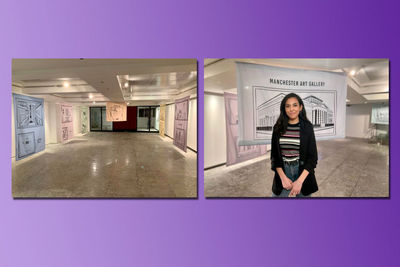Art communicates across every border and culture. Visual art is open and ambiguous and allows imaginations to wander in time and space. Through London-based artist Alaa Alsaraji, they even wander into people's homes.
With her family coming from Iraq, she was born in Iran and raised in Austria. Alsaraji has witnessed the rise of Islamophobia, fuelled by hateful media rhetoric, state surveillance, and the demonization and criminalization of Muslim communities. She notes, however, that despite these internal and external conflicts which have expanded over generations, communities have established and maintained their own safe-havens.
Her online exhibition, "Mapping Sanctuaries", was initially displayed at London's P21 Gallery. It features a collection of digital illustrations and sound pieces brought by reAct, an innovative program that promotes dialogue between East and West. Each softly hanging canvas belongs to two authors, the artist, and the subject. The illustrator enjoys drawing from life and amplifying the world and people around her, especially the stories of British Muslims.
There is an issue with the common but unspoken xenophobia pervasive in British society that casts Muslims as outsiders, says Alsaraji. In the light of Islamophobia, racism, and a general sense of being "othered" within mainstream society, British Muslims from different backgrounds have shared their personal sanctuary with the artist.
"I illustrated the spaces that we talked about and I used the interviews to edit down a shorter, digestible sound piece that can sit alongside the illustrations to give them more context and understanding as to why space might hold that kind of weight for someone," she explains.

Othering and marginalization can occur on a group basis or at the individual level. British Muslims are all likely to have experienced the discomfort of being in a place or with people where they did not feel that they belong, she tells me. "This exhibition revolves around the themes of safety, belonging, and familiarity with a space or a place within British Muslim communities. This art is about them."
Bringing out the textures of the fabric that displays subtle folds of decorative floral patterns, the pieces take on a dynamic life of their own with an almost comic book aesthetic by the use of modern digital techniques. "It really made me understand the ideas around safety and belonging in a much more nuanced and varied way. So there's also variety in what people said in interviews and what they reflected on and what they feel emotionally connected to. It was beautiful to see that unfold in different directions with each interview."
The paintings have been viewed in locations such as Whitechapel, Green Street and alternative community hub Rumi's Cave in London, and even a bedroom. Viewers may have visited the location before and met Muslims, but the emotional response to Alaa Alsaraji's work testifies to a shared fund of emotional experience, connection, and discovery of local stories.
Alaa Alsaraji's art collection boils down to the importance of authenticity and providing an honest narrative and viewpoint. She has provided a complete picture showing that British Muslims are integrated and have found places to feel at home in Britain.

